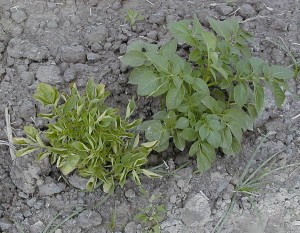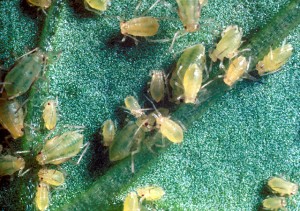
In difficult economic times, it is important to protect one’s income and to reduce living costs. I decided to plant a garden! Although I was inclined to plant more expensive vegetable varieties, I included onions, tomatoes, and potatoes. I felt certain these “insurance crops” would guarantee I would experience a bountiful harvest.
Know Thine Enemy
I knew there would be familiar pests I’d have to deal—especially the Colorado potato beetle, but that didn’t worry me too much. To improve savings, I decided to use left over potatoes from my pantry that had developed eyes, rather than buying specially prepared seed-potatoes.
Overconfidence
Not doing my research, I failed to take into account the Potato Leaf Roll Virus (PLRV). As its name suggests, leaf edges of infected plants curl up, yielding unsightly, stunted growth. Unfortunately what occurs above ground suggests underground damage to the tubers themselves.
The major source of spread of this luteovirus is via the green peach aphid. This aphid is plentiful in nature, since not only the potato, but a variety of plants serve as hosts. Besides damaging leaf appearance, photosynthesis is reduced, limiting size and vigor.
I Had to Pay the Piper

Among those other related host plants are members of the Solanaceae or nightshade family. These include the tomato, eggplant, and bell pepper. Fortunately for eggplant enthusiasts, the fruit itself apparently does not suffer. But of the potatoes I planted, I harvested not one tuber out of three rows!
Good News – Potato Leaf Roll Virus
A bit of good news: genetic modification techniques have led to the discovery of a sequence of DNA that may be utilized to negate the ill-effects of PLRV. Called the orf1/orf2 gene, this promises to afford a reduction in the need of organophosphate treatment.
However, genetic modification is, itself, controversial. How do you feel about it? Some forms of genetic modification include splicing a portion of animal DNA into plants. And to many, it is like monkeying with God’s handiwork. Like many other areas in life, there are pluses and minuses whatever choice we may make.
Note: You might also enjoy What Factors Cause the 1840s Irish Potato Famine?
References:
